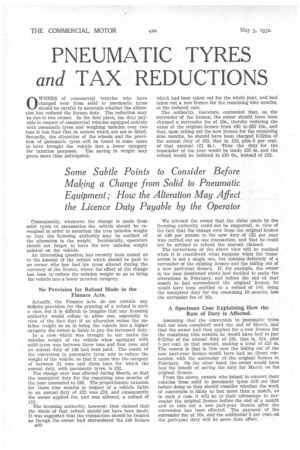PNEUMATIC TYRES
Page 122

If you've noticed an error in this article please click here to report it so we can fix it.
and TAX REDUCTIONS 0 WNERS of commercial vehicles who have changed over from solid to pneumatic tyres should be careful to ascertain whether the alteration has reduced the licence duty. The reduction may be due to two causes. In the first place, the duty payable in respect of commercial vehicles equipped entirely with pneumatic tyres and weighing unladen over two tons is less than that on motors which are not so fitted. Secondly, the alteration of the wheels and the provision of pneumatic tyres will be found in some cases to have brought the vehicle into a lower category for taxation purposes. The saving in weight may prove more than anticipated.
which had been taken out for the whole year, and had taken out a new licence for the remaining nine months, at the reduced rate.
The authority, therefore, contended that, on the surrender of the licence, the owner should have been charged a surrender fee of 10s., thereby reducing the value of the original licence from £36 to 135 10s., and that, upon taking out the new licence for the remaining nine months, he should have been charged 9-12ths of the annual duty of £32, that is 124, plus 5 per cent. of that amount (£1 4s.). Thus the duty for the remainder of the year would be made 125 4s. and the refund would be reduced to £10 Os., instead of £12.
Consequently, whenever the change is made from solid tyres to pneumatics the vehicle should be reweighed in order to ascertain the true unladen weight so that the licensing authority may be notified of the alteration in the weight. Incidentally, operators should not forget to have the new unladen weight painted on the vehicle.
An interesting question has recently been raised as to the amount of the refund which should be paid to an owner who has had his tyres altered during the currency of the licence, where the effect of the change has been to reduce the unladen weight so as to bring the vehicle into a lower taxation category.
No Provision for Refund Made in the Finance Acts.
Actually, the Finance Acts do not contain any definite provision for the granting of a refund in such a case, but it is difficult to imagine that any licensing authority would refuse to allow one, especially in view of the fact that if an alteration raises the unladen weight so as to bring the vehicle into a higher category the owner is liable to pay the increased duty.
In a ease which was brought to our notice the unladen weight of the vehicle when equipped with solid tyres was between three tons and four tons, and an annual duty of £48 had been paid. The result of the conversion to penumatic tyres was to reduce the weight of the vehicle, so that it came into the category of between 2i tons and three tons, for which the annual duty, with pneumatic tyres, is £32.
The change over was effected during March, so that the unexpired duty for the remaining nine months of the year amounted to 136. The proportionate taxation for those nine months in respect of a vehicle liable to an annual duty of £32 was £24, and consequently the owner applied for, and was allowed, a refund of £12.
The licensing authority, however, then claimed that the whole of that refund should not have been made. It was suggested that the transaction should be treated as though the owner had surrendered the £48 licence D60 We advised the owner that the claim made by the licensing authority could not be supported, in view of the fact that the change over from the original licence at £48 per annum to the new duty of £32 per year was carried out as one transaction, and that he could not be advised to refund the amount claimed.
The correctness of the above view will be realized when it is considered what happens when the transaction is not a single one, but consists definitely of a surrender of the existing licence and the taking out at a new part-year licence. If, for example, the owner in the case mentioned above had decided to make the alterations in February, and before the end of that month he had surrendered the original licence, he would have been entitled to a refund of £40, being the unexpired duty for the remaining 10 months, less the surrender fee of 10s.
A Specimen Case Explaining How the Rate of Duty is Affected.
Assuming that the conversion to pneumatic tyres had not been completed until the end of March, and that the owner had then applied for a new licence for the remaining nine months, he would have had to pay 9-12ths of the annual duty of £22, that is, £24, plus 5 per cent. on that amount, making a total of £25 4s. The reason is that in this case the taking out of the new part-year licence would have had no direct connection with the surrender of the original licence in February. On the other hand, the owner would have had the benefit of saving the duty for March on the original licence.
From the above, owners who intend to convert their vehicles from solid to pneumatic tyres will see that before doing so they should consider whether the work of conversion is likely to last more than a month, as in such a case it will be to their advantage to surrender the original licence before the end of a month and to take out a new part-year licence after the conversion has been effected. The payment of the surrender fee of 10s. and the additional 5 per cent, an the part-year duty will be more than offset.
















































































































































































